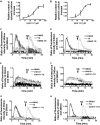Dual mechanisms of sHA 14-1 in inducing cell death through endoplasmic reticulum and mitochondria
- PMID: 19561125
- PMCID: PMC2730395
- DOI: 10.1124/mol.109.055830
Dual mechanisms of sHA 14-1 in inducing cell death through endoplasmic reticulum and mitochondria
Abstract
HA 14-1 is a small-molecule Bcl-2 antagonist that promotes apoptosis in malignant cells, but its mechanism of action is not well defined. We recently reported that HA 14-1 has a half-life of only 15 min in vitro, which led us to develop a stable analog of HA 14-1 (sHA 14-1). The current study characterizes its mode of action. Because of the antiapoptotic function of Bcl-2 family proteins on the endoplasmic reticulum (ER) and mitochondria, the effect of sHA 14-1 on both organelles was evaluated. sHA 14-1 induced ER calcium release in human leukemic cells within 1 min, followed by induction of the ER stress-inducible transcription factor ATF4. Similar kinetics and stronger intensity of ER calcium release were induced by the sarcoendoplasmic reticulum Ca(2+)-ATPase (SERCA) inhibitor thapsigargin, accompanied by similar kinetics and intensity of ATF4 induction. sHA 14-1 directly inhibited SERCA enzymatic activity but had no effect on the inositol triphosphate receptor. Evaluation of the mitochondrial pathway showed that sHA 14-1 triggered a loss of mitochondrial transmembrane potential (Delta psi m) and weak caspase-9 activation, whereas thapsigargin had no effect. (R)-4-(3-Dimethylamino-1-phenylsulfanylmethyl-propylamino)-N-{4-[4-(4'-chloro-biphenyl-2-ylmethyl)-piperazin-1-yl]-benzoyl}-3-nitrobenzenesulfonamide (ABT-737), a well established small-molecule Bcl-2 antagonist, rapidly induced loss of Delta psi m and caspase-9 activation but had no effect on the ER. The pan-caspase inhibitor N-benzyloxycarbonyl-Val-Ala-Asp-fluoromethyl ketone had some protective effect on sHA 14-1-induced cell death. These collective results suggest a unique dual targeting mechanism of sHA 14-1 on the apoptotic resistance machinery of tumor cells that includes antiapoptotic Bcl-2 family proteins and SERCA proteins.
Figures








References
-
- An J, Chen Y, and Huang Z (2004) Critical upstream signals of cytochrome c release induced by a novel Bcl-2 inhibitor. J Biol Chem 279 19133-19140. - PubMed
-
- An J, Chervin AS, Nie A, Ducoff HS, and Huang Z (2007) Overcoming the radioresistance of prostate cancer cells with a novel Bcl-2 inhibitor. Oncogene 26 652-661. - PubMed
-
- Bilmen JG and Michelangeli F (2002) Inhibition of the type 1 inositol 1,4,5-trisphosphate receptor by 2-aminoethoxydiphenylborate. Cell Signal 14 955-960. - PubMed
-
- Birmachu W, Nisswandt FL, and Thomas DD (1989) Conformational transitions in the calcium adenosinetriphosphatase studied by time-resolved fluorescence resonance energy transfer. Biochemistry 28 3940-3947. - PubMed
Publication types
MeSH terms
Substances
Grants and funding
LinkOut - more resources
Full Text Sources
Other Literature Sources
Miscellaneous

